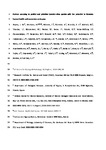Horizon Scanning to Predict and Prioritize Invasive Alien Species With the Potential to Threaten Human Health and Economies on Cyprus
| dc.contributor.author | Peyton, JM | |
| dc.contributor.author | Martinou, AF | |
| dc.contributor.author | Adriaens, T | |
| dc.contributor.author | Chartosia, N | |
| dc.contributor.author | Karachle, PK | |
| dc.contributor.author | Rabitsch, W | |
| dc.contributor.author | Tricarico, E | |
| dc.contributor.author | Arianoutsou, M | |
| dc.contributor.author | Bacher, S | |
| dc.contributor.author | Bazos, I | |
| dc.contributor.author | Brundu, G | |
| dc.contributor.author | Bruno-McClung, E | |
| dc.contributor.author | Charalambidou, I | |
| dc.contributor.author | Demetriou, M | |
| dc.contributor.author | Galanidi, M | |
| dc.contributor.author | Galil, B | |
| dc.contributor.author | Guillem, R | |
| dc.contributor.author | Hadjiafxentis, K | |
| dc.contributor.author | Hadjioannou, L | |
| dc.contributor.author | Hadjistylli, M | |
| dc.contributor.author | Hall-Spencer, Jason | |
| dc.contributor.author | Jimenez, C | |
| dc.contributor.author | Johnstone, G | |
| dc.contributor.author | Kleitou, Periklis | |
| dc.contributor.author | Kletou, D | |
| dc.contributor.author | Koukkoularidou, D | |
| dc.contributor.author | Leontiou, S | |
| dc.contributor.author | Maczey, N | |
| dc.contributor.author | Michailidis, N | |
| dc.contributor.author | Mountford, JO | |
| dc.contributor.author | Papatheodoulou, A | |
| dc.contributor.author | Pescott, OL | |
| dc.contributor.author | Phanis, C | |
| dc.contributor.author | Preda, C | |
| dc.contributor.author | Rorke, S | |
| dc.contributor.author | Shaw, R | |
| dc.contributor.author | Solarz, W | |
| dc.contributor.author | Taylor, CD | |
| dc.contributor.author | Trajanovski, S | |
| dc.contributor.author | Tziortzis, I | |
| dc.contributor.author | Tzirkalli, E | |
| dc.contributor.author | Uludag, A | |
| dc.contributor.author | Vimercati, G | |
| dc.contributor.author | Zdraveski, K | |
| dc.contributor.author | Zenetos, A | |
| dc.contributor.author | Roy, HE | |
| dc.date.accessioned | 2020-12-07T14:31:21Z | |
| dc.date.issued | 2020-10-21 | |
| dc.identifier.issn | 2296-701X | |
| dc.identifier.issn | 2296-701X | |
| dc.identifier.other | ARTN 566281 | |
| dc.identifier.uri | http://hdl.handle.net/10026.1/16718 | |
| dc.description.abstract |
Invasive alien species (IAS) are known to be a major threat to biodiversity and ecosystem function and there is increasing evidence of their impacts on human health and economies globally. We undertook horizon scanning using expert-elicitation to predict arrivals of IAS that could have adverse human health or economic impacts on the island of Cyprus. Three hundred and twenty five IAS comprising 89 plants, 37 freshwater animals, 61 terrestrial invertebrates, 93 terrestrial vertebrates, and 45 marine species, were assessed during a two-day workshop involving 39 participants to derive two ranked lists: (1) IAS with potential human health impacts (20 species ranked within two bands: 1–10 species or 11–20 species); and, (2) IAS with potential economic impacts (50 species ranked in three bands of 1–10, 11–20, and 21–50). Five species of mosquitoes (Aedes aegypti, Aedes albopictus, Aedes flavopictus, Aedes japonicus, and Culex quinquefasciatus) were considered a potential threat to both human health and economies. It was evident that the IAS identified through this process could potentially arrive through many pathways (25 and 23 pathways were noted for the top 20 IAS on the human health and economic impact lists respectively). The Convention on Biological Diversity Level II (subcategory) pathways Contaminant on plants, pet/aquarium/terrarium species (including live food for such species), hitchhikers in or on aeroplanes, hitchhikers in or on ship/boats, and vehicles were the main pathways that arose across both lists. We discuss the potential of horizon scanning lists to inform biosecurity policies and communication around IAS, highlighting the importance of increasing understanding amongst all stakeholders, including the public, to reduce the risks associated with predicted IAS arrivals. | |
| dc.format.extent | 566281- | |
| dc.language.iso | en | |
| dc.publisher | Frontiers Media SA | |
| dc.subject | prevention | |
| dc.subject | non-native species | |
| dc.subject | negative impact | |
| dc.subject | environmental management | |
| dc.subject | introduction pathways | |
| dc.subject | communication | |
| dc.title | Horizon Scanning to Predict and Prioritize Invasive Alien Species With the Potential to Threaten Human Health and Economies on Cyprus | |
| dc.type | journal-article | |
| dc.type | Journal Article | |
| plymouth.author-url | https://www.webofscience.com/api/gateway?GWVersion=2&SrcApp=PARTNER_APP&SrcAuth=LinksAMR&KeyUT=WOS:000585625700001&DestLinkType=FullRecord&DestApp=ALL_WOS&UsrCustomerID=11bb513d99f797142bcfeffcc58ea008 | |
| plymouth.volume | 8 | |
| plymouth.publication-status | Published online | |
| plymouth.journal | Frontiers in Ecology and Evolution | |
| dc.identifier.doi | 10.3389/fevo.2020.566281 | |
| plymouth.organisational-group | /Plymouth | |
| plymouth.organisational-group | /Plymouth/Faculty of Science and Engineering | |
| plymouth.organisational-group | /Plymouth/Faculty of Science and Engineering/School of Biological and Marine Sciences | |
| plymouth.organisational-group | /Plymouth/PRIMaRE Publications | |
| plymouth.organisational-group | /Plymouth/REF 2021 Researchers by UoA | |
| plymouth.organisational-group | /Plymouth/REF 2021 Researchers by UoA/UoA07 Earth Systems and Environmental Sciences | |
| plymouth.organisational-group | /Plymouth/Research Groups | |
| plymouth.organisational-group | /Plymouth/Research Groups/Marine Institute | |
| plymouth.organisational-group | /Plymouth/Users by role | |
| plymouth.organisational-group | /Plymouth/Users by role/Academics | |
| dcterms.dateAccepted | 2020-08-12 | |
| dc.rights.embargodate | 2020-12-10 | |
| dc.identifier.eissn | 2296-701X | |
| dc.rights.embargoperiod | Not known | |
| rioxxterms.versionofrecord | 10.3389/fevo.2020.566281 | |
| rioxxterms.licenseref.uri | http://www.rioxx.net/licenses/all-rights-reserved | |
| rioxxterms.licenseref.startdate | 2020-10-21 | |
| rioxxterms.type | Journal Article/Review |


